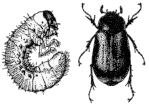|
What is white grub?
White grubs are the larva of certain scarab beetles, such
as June bugs, European Chafer and others. The larva
feed on roots of grass or various plants, depending on the
species. In a healthy lawn, having up to 4 or 5 per square
foot is normal. However, once the number of grub
exceeds 10 or even 20 per square foot, the lawn is
considered infested, and the grass gets severely damaged or
destroyed by having it's roots eaten. The lawn then
turns yellow and feels spongy when we walk on it. Raccoons,
skunks and birds tear up an infested turf to find the white
larvae.
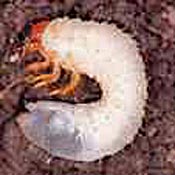 <===>
<===>
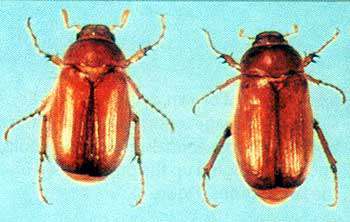
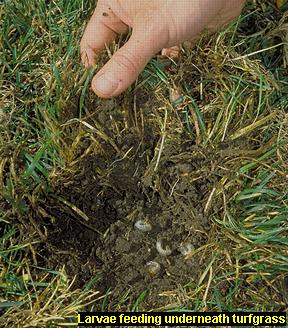
|
|
What species of grub is invading Beaconsfield?
In the last few years, lawn owners in countless Canadians
towns and cities, from Vancouver to Halifax, have been struggling
with grub infestations caused by various beetles. The
white grubs currently infesting Beaconsfield lawns are the
larva of the European Chafer. This insect has a
one year life cycle: The adult beetle, resembling a
June bug, lays eggs around end of June and beginning of July
which subsequently hatch into baby white grubs. The grubs feed on grass roots from
August to November. The grubs burry deep in the soil
when frost arrives. After spring thaw, around May or
June, they come up to the surface again to devour more grass
roots (and this time they are big and even more voracious).
Finally, they change into beetles and emerge from the ground
in mid-June. They mate and lay their eggs over a
period of about 3 weeks - end of June, beginning of July.
|
|
Why do I have white grub in my lawn and my
neighbour doesn't?
Partly, it's "luck". However, the beetles
who are ready to lay their eggs generally choose a lawn where it is
easy for them to land, lay the eggs and take off flying
again. So, they like
- bare ground patches
- loose, sandy, dry soil
- lawns which are mowed short (shorter than 3 inches) where take-off is
easy
- light at night - they are attracted to light
ornaments, lanterns, etc.
They will generally avoid:
- thick lawns mowed high (more than 3 inches) where
landing and take-off is hard
- non-grass ground covers
- eating clover in their larva state
|
|
How do I treat my lawn which is infested with white
grub?
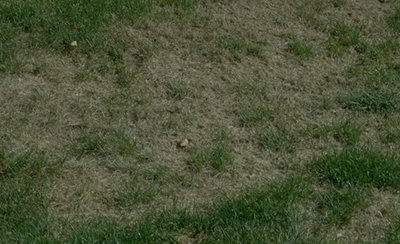 To protect human health, synthetic pesticides are banned
in Beaconsfield. A natural alternative exists, and
that is an application of "nematodes" on
the damaged lawn area and up to a meter around its
perimeter. Nematodes are microscopic worms which are
parasitic to the grub, that is they enter the grubs' bodies
and eat them. Once they run out of grubs they die
out. Nematodes can be purchased at most West Island
nurseries and garden centres. The time to apply
nematodes is when the white grubs are close to the lawn
surface and ideally when they are small and vulnerable
(August or beginning of September). In May and June the
grub are also close to the surface, but they are big and
more resistant, so a nematode application is less effective. Applying nematodes means keeping
them refrigerated until application time, choosing an
evening (they become ineffective if exposed to light) and
spraying them over the affected lawn area using a hose-end
sprayer. The area then needs to be kept soaked for
5-10 days to allow the drought-sensitive nematodes to live
and "swim" through the soil to reach their pray
for as long as possible. The cost of nematodes
comes to around $40 for covering a 2000
square feet area. To protect human health, synthetic pesticides are banned
in Beaconsfield. A natural alternative exists, and
that is an application of "nematodes" on
the damaged lawn area and up to a meter around its
perimeter. Nematodes are microscopic worms which are
parasitic to the grub, that is they enter the grubs' bodies
and eat them. Once they run out of grubs they die
out. Nematodes can be purchased at most West Island
nurseries and garden centres. The time to apply
nematodes is when the white grubs are close to the lawn
surface and ideally when they are small and vulnerable
(August or beginning of September). In May and June the
grub are also close to the surface, but they are big and
more resistant, so a nematode application is less effective. Applying nematodes means keeping
them refrigerated until application time, choosing an
evening (they become ineffective if exposed to light) and
spraying them over the affected lawn area using a hose-end
sprayer. The area then needs to be kept soaked for
5-10 days to allow the drought-sensitive nematodes to live
and "swim" through the soil to reach their pray
for as long as possible. The cost of nematodes
comes to around $40 for covering a 2000
square feet area.
|
|
What if my lawn is ravaged by racoons, skunks and
birds (eating the grub)?
Nature's useful predators such as raccoons and skunks have yet to be trained to tidy
after themselves! If the grub-infested area is
not huge, covering the yellowed grub-infested area with chicken wire
will prevent predator access until the grubs mature, change
into beetles and fly away in June.
If the area is too large to cover with chicken wire, you
can try some of the following options to chase pests of your
lawn:
- Raccoons don't like getting wet. A motion
detector sprinkler available at Lee Valley Hardware
can be set to spray water when anything moves within its
field of view.
- "Scent-a-gone" and "Fiche le
Camp" are 100% natural products (cayenne pepper,
etc.) that can be sprinkled
all around your garden and should repel many of the pests
for up to 30 days.
You may alternatively chose to wait
for the beetles to emerge in June, re-cover and re-seed the
area and then treat again with nematodes in August (see above) so
that the new lawn doesn't suffer the same damage in the fall
and next spring.
Rather than completely rebuilding a very damaged lawn it may be a good time to consider
replanting with alternative ground cover which won't
be attractive to the grub in the next season. Some
excellent hardy
plants include hostas or ferns (under trees), white clover
(sprinkled throughout the lawn or on its own) and periwinkle, to mention some of the most popular plants.
|
|
How do I prevent white grub from (re-)infesting my lawn?
We want
to make our lawn
- not attractive to the beetles who want to lay their
eggs at the end of June and beginning of July and also
- somewhat resistant to the ravages caused by their
larva, the white grub.
In general, try to
- replace a vulnerable monoculture of one type of grass
by a mixture of different grasses and white
clover. A
healthy mixed grass lawn can tolerate up to 60 grubs per
square foot!
- aerate, fertilize (preferably with compost) and reseed
your lawn yearly or bi-annually to keep it lush
- Mow high at minimum 3 inches (so mower set at 4
inches)
- water infrequently but deeply if desired to
ensure the turf develops deep and healthy roots, more
resistant to any root-feeding larva.
- do not install small garden lamps, or at least avoid
turning them on from mid-June to mid-July, when
egg-laying beetles are attracted by them
|
